Where KRAUSE is, is Safety - the standard EN 131 for ladders
Key features
On January 1st, 2018, extensive standard changes came into force for all ladders that can be used as leaning ladders and are more than 3 m long. The changes to the EN 131 standard affect all commercial users who use ladders as work equipment. The changes essentially relate to the width of the ladders and are intended to increase the safety of working on these types of ladders.
Since December 2017 we have been delivering all ladders according to the new standard. Commercial users, those responsible for production and safety can thus invest safely and in accordance with standards. In addition, we provide you with an extensive portfolio of free information on standard changes.
The following pages contain summaries of the key features of relevant standards and laws, amendments and specific information on the new version of DIN EN 131, the standard governing ladders:
Key features of the new version of EN 131 for all industrial and commercial users
Dear readers,
Many thanks for your interest in our information on the new amended version of DIN EN 131, the standard governing ladders.
As of 1 January 2018, EN 131 will incorporate a range of upgraded requirements for ladders over 3 m that qualify as leaning ladders that will affect all industrial and commercial users.
The changes in Part 131-1 primarily refer to the width of the ladders at the base and are intended to help prevent the main causes of ladder related accidents. An important aspect of these new requirements is that industrial and commercial users will be required to check their existing ladders by a risk assessment.

As of 1 December 2017 our new EN 131-compliant range of industrial and commercial ladders will be available and we will also be providing a comprehensive range of testing and certification services for existing ladders.
Part 131-2 refers to the new ladder tests. It divides ladders into two classes and comes into effect on 01.01.2018, at the same time as Part 1. The other changes to this standard will be coming into effect at a later date.
When buying a new ladder, make sure it carries this label:

DIN EN 131-3
The third part of the standard DIN EN 131-3 regularises the requirements for identification marks such as the labeling and the pictograms for the ladders as well as the content of the instruction manual. With commencemenet of the standard the marking of the ladders will be extended by further safety pictograms. The pictograms comply with the respective ladder type (e. g. extension ladders, multipurpose ladders, step ladders etc.). Beside the new pictograms an instruction manual for the respective ladder type must be delivered together with the ladder. The instruction manual must be provided in all languages of the countries where the ladders are sold.
Recently, changes to the fourth section of the standard also came into effect and relate to single-hinged and multi-hinged ladders. Since 2018, our multipurpose hinged ladders feature standard-compliant stabilisers as well as labeling for professional use and corresponding user and operating instructions. Due to the changes in the revised standard, all of our multipurpose hinged ladders
with 4 x 3 rungs, which can also be set up as a working platform, must always be supplied by the manufacturer with a suitable platform for such models. This is required for all multipurpose hinged ladders of our three product lines STABILO, MONTO and CORDA.
This means that you will be able to work safely and safely invest in new ladders in compliance with the relevant standards.
Where KRAUSE is, is safety
If you are an industrial and commercial user or service provider, the following questions are likely to be top of your list:
- What exactly do these changes mean and what kind of ladders do they apply to?
- Will they affect the ladders we use in our company?
- How can I can a make a risk assessment with my existing ladders?
- What requirements will I have to fulfil to avoid being held liable for any safety risks?
- How can I make sure that all of my existing ladders meet these requirements and upgrade them as required?
A reminder:
The changes to DIN EN 131-1 mean that all leaning ladders over 3 m must have extra wide legs or an extra wide base. This applies to leaning, extension, rope-operated and sliding inner sections of our multi-purpose and multipurpose ladders. This requirement can also be fulfilled by using a stabilizer.
In addition to the above, all existing equipment designed to widen the base of a ladder should be amended such as to comply with the new standard. The above specifications also form the basis of the risk assessment to be performed on all existing ladders.

The KRAUSE solution
1. Our ladders:
As of 1 December 2017, all of our ladders, including leaning, extension and rope-operated ladders subject to the requirements of EN 131, will not only feature the required stabilisers, but, in some cases, exceed the minimum requirements.
2. Upgrading old ladders:
We stock a range of equipment for upgrading existing ladders in compliance with the new standard.
3. Our special Trigon stabiliser
A stabiliser specially designed for the narrow ladder sections of extension and multi-purpose ladders to ensure compliance of these kind of ladders across all areas of use.
Key features of the new version of EN 131 for safety officers
Dear safety officers,
many thanks for your interest in our information on the new amended version of DIN EN 131, the standard governing ladders.
As everyone providing advice on the subject of working at height and occupational safety will be aware of, there will be a number of important changes to the regulations governing ladders at European level as of 1 January 2018. These changes will affect all professional ladders over 3 m that are suitable for use as leaning ladders.
The changes in Part 131-1 primarily refer to the width of the ladders at the base and are intended to help prevent the main causes of ladder related accidents. An important aspect of these new requirements is that industrial and commercial users will be required to check their existing ladders by a risk assessment.

As of 1 December 2017 our new EN 131-compliant range of industrial and commercial ladders will be available and we will also be providing a comprehensive range of testing and certification services for existing ladders.
Part 131-2 refers to the new ladder tests. It divides ladders into two classes and comes into effect on 01.01.2018, at the same time as Part 1. The other changes to this standard will be coming into effect at a later date.
When buying a new ladder, make sure it carries this label:

DIN EN 131-3
The third part of the standard DIN EN 131-3 regularises the requirements for identification marks such as the labeling and the pictograms for the ladders as well as the content of the instruction manual. With commencemenet of the standard the marking of the ladders will be extended by further safety pictograms. The pictograms comply with the respective ladder type (e. g. extension ladders, multipurpose ladders, step ladders etc.). Beside the new pictograms an instruction manual for the respective ladder type must be delivered together with the ladder. The instruction manual must be provided in all languages of the countries where the ladders are sold.
Recently, changes to the fourth section of the standard also came into effect and relate to single-hinged and multi-hinged ladders. Since 2018, our multipurpose hinged ladders feature standard-compliant stabilisers as well as labeling for professional use and corresponding user and operating instructions. Due to the changes in the revised standard, all of our multipurpose hinged ladders
with 4 x 3 rungs, which can also be set up as a working platform, must always be supplied by the manufacturer with a suitable platform for such models. This is required for all multipurpose hinged ladders of our three product lines STABILO, MONTO and CORDA.
This means that you will be able to work safely and safely invest in new ladders in compliance with the relevant standards.
Where KRAUSE is, is safety
If you are an industrial and commercial user or service provider, the following questions are likely to be top of your list:
- What exactly do these changes mean and what kind of ladders do they apply to?
- Will they affect the ladders we use in our company?
- How can I can a make a risk assessment with my existing ladders?
- What requirements will I have to fulfil to avoid being held liable for any safety risks?
- How can I make sure that all of my existing ladders meet these requirements and upgrade them as required?
A reminder:
The changes to DIN EN 131-1 mean that all leaning ladders over 3 m must have extra wide legs or an extra wide base. This applies to leaning, extension, rope-operated and sliding inner sections of our multi-purpose and multipurpose ladders. This requirement can also be fulfilled by using a stabilizer.
In addition to the above, all existing equipment designed to widen the base of a ladder should be amended such as to comply with the new standard. The above specifications also form the basis of the risk assessment to be performed on all existing ladders.

The KRAUSE solution
1. Our ladders:
As of 1 December 2017, all of our ladders, including leaning, extension and rope-operated ladders subject to the requirements of EN 131, will not only feature the required stabilisers, but, in some cases, exceed the minimum requirements.
2. Upgrading old ladders:
We stock a range of equipment for upgrading existing ladders in compliance with the new standard.
3. Our special Trigon stabiliser
A stabiliser specially designed for the narrow ladder sections of extension and multi-purpose ladders to ensure compliance of these kind of ladders across all areas of use.
Key features of the new version of EN 131 for production officers
Dear production officers,
All industrial and commercial users that employ leaning ladders over 3 m will be subject to a number of important changes to the standard governing ladders at European level as of 1 January 2018. For this reason, we have put together a comprehensive information pack that details the most important occupational safety information. This will make working safely, safely investing new ladders and staying up-to-date a lot easier.
The changes in Part 131-1 primarily refer to the width of the ladders at the base and are intended to help prevent the main causes of ladder related accidents. An important aspect of these new requirements is that industrial and commercial users will be required to check their existing ladders by a risk assessment.

As of 1 December 2017 our new EN 131-compliant range of industrial and commercial ladders will be available and we will also be providing a comprehensive range of testing and certification services for existing ladders.
Part 131-2 refers to the new ladder tests. It divides ladders into two classes and comes into effect on 01.01.2018, at the same time as Part 1. The other changes to this standard will be coming into effect at a later date.
When buying a new ladder, make sure it carries this label:

DIN EN 131-3
The third part of the standard DIN EN 131-3 regularises the requirements for identification marks such as the labeling and the pictograms for the ladders as well as the content of the instruction manual. With commencemenet of the standard the marking of the ladders will be extended by further safety pictograms. The pictograms comply with the respective ladder type (e. g. extension ladders, multipurpose ladders, step ladders etc.). Beside the new pictograms an instruction manual for the respective ladder type must be delivered together with the ladder. The instruction manual must be provided in all languages of the countries where the ladders are sold.
Recently, changes to the fourth section of the standard also came into effect and relate to single-hinged and multi-hinged ladders. Since 2018, our multipurpose hinged ladders feature standard-compliant stabilisers as well as labeling for professional use and corresponding user and operating instructions. Due to the changes in the revised standard, all of our multipurpose hinged ladders
with 4 x 3 rungs, which can also be set up as a working platform, must always be supplied by the manufacturer with a suitable platform for such models. This is required for all multipurpose hinged ladders of our three product lines STABILO, MONTO and CORDA.
This means that you will be able to work safely and safely invest in new ladders in compliance with the relevant standards.
Where KRAUSE is, is safety
If you are an industrial and commercial user or service provider, the following questions are likely to be top of your list:
- What exactly do these changes mean and what kind of ladders do they apply to?
- Will they affect the ladders we use in our company?
- How can I can a make a risk assessment with my existing ladders?
- What requirements will I have to fulfil to avoid being held liable for any safety risks?
- How can I make sure that all of my existing ladders meet these requirements and upgrade them as required?
A reminder:
The changes to DIN EN 131-1 mean that all leaning ladders over 3 m must have extra wide legs or an extra wide base. This applies to leaning, extension, rope-operated and sliding inner sections of our multi-purpose and multipurpose ladders. This requirement can also be fulfilled by using a stabilizer.
In addition to the above, all existing equipment designed to widen the base of a ladder should be amended such as to comply with the new standard. The above specifications also form the basis of the risk assessment to be performed on all existing ladders.

The KRAUSE solution
1. Our ladders:
As of 1 December 2017, all of our ladders, including leaning, extension and rope-operated ladders subject to the requirements of EN 131, will not only feature the required stabilisers, but, in some cases, exceed the minimum requirements.
2. Upgrading old ladders:
We stock a range of equipment for upgrading existing ladders in compliance with the new standard.
3. Our special Trigon stabiliser
A stabiliser specially designed for the narrow ladder sections of extension and multi-purpose ladders to ensure compliance of these kind of ladders across all areas of use.
Standards, laws and regulations for ladders and scaffolds
Standards, laws and regulations - it's easy to loose track of what is what. Partnering with us means that you will always be up to date about the latest safety information. The following section contains a short list of the most important standards, amendments and regulations for ladders and scaffolds.
DIN standards
Standards are recognised engineering rules intended to ensure the safety of products and services. All DIN standards can be purchased from the publisher Beuth-Verlag. Beuth-Verlag is a subsidiary of the German Institute for Standardization (DIN).
DIN EN 131 - Ladders is a standard that comprises six different parts and deals with terms, types, functional sizes; requirements, testing, marking; safety information, user instructions, hinged and mobile platform ladders.
- DIN EN 131-1: Terms, types, functional sizes
- DIN EN 131-2: Requirements, testing, marking
- DIN EN 131-3: User instructions
- DIN EN 131-4: Single or multiple hinged ladders
- DIN EN 131-6: Telescopic ladders
- DIN EN 131-7: Mobile platform ladders
DIN EN 14183 – Step stools - This standard specifies the requirements for step stools. This includes design characteristics, dimensions, materials, performance requirements, test methods and the declaration of suitability of use.
DIN EN 1004 – Mobile access and working towers: A one-part standard on mobile access and working towers made of prefabricated elements - Materials, dimensions, design loads, safety and performance requirements.
DIN EN ISO 14122 – Safety of machinery - fixed access to machinery: This standard comprises four different parts that deal with the choice of fixed access between two levels as well as working platforms and walkways, stairs, stepladders and guard-rails and fixed ladders.
DIN 14094-1 – Escape ladder installations are installations for rescuing humans. DIN 18799-1 – Fixed ladders at architectural facilities for maintenance and service work.
Laws
ArbSchG – German Occupational Health and Safety Act:
Law about the performance of occupational health and safety measures to improve safety and for the protection of health in the workplace.
BetrSichV – German Ordinance on Industrial Safety and Health:
Ordinance about the safety of work equipment and installations.
Workplace Ordinance (ArbStättV):
The German Worker Protection Law specifies the requirements for safe and healthy workplaces. The Workplace Ordinance contains the regulations and requirements that companies have to comply with when furnishing and operating workplaces.
Technical Regulations for Workplaces - Traffic routes - (ASR A1.8):
Compliance with these regulations is a means to ensure that employers are meeting the relevant requirements of the ordinance. Any alternative solutions have to provide employees with an equivalent level of occupational health and safety as a minimum.
Technical Regulations for Operating Safety (TRBS 2121 Fall Hazards):
Part 1 Provision and use of scaffolds
Part 2 Provision and use of ladders
DGUV Regulations, rules and information
DGUV Information 208-016:
Operating instructions for ladders and steps. These instructions were previously designated BGI 694.
DGUV Information 201-011:
Operating instructions for working and safety scaffolds. These instructions were previously designated BGI/GUV-I 663.
DGUV Information 208-032:
Choice and use of fixed ladders. These instructions were previously designated BGI/GUV-I 5189.
DGUV Regel 112-198:
Use of personal fall arrest systems. These instructions were previously designated BGI/GUV-I 198.
FAQ about standard DIN EN 131
EN 131 is the European standard for mobile ladders and addresses (in several parts) the following subcategories:
- EN 131‐1 ‐ this part addresses terms, types, and functional sizes of certain ladders.
- EN 131-2 - this part addresses testing, marking, and requirements of all ladders.
- EN 131‐3 ‐ this part addresses the requirements for user instructions of ladders.
- EN 131‐4 ‐ part 4 addresses single or multiple hinged ladders
- EN 131‐6 ‐ part 6 addresses telescopic ladders
- EN 131‐7 ‐ part 7 addresses mobile platform ladders
The aim of the standard is to guarantee uniform quality and safety standards throughout Europe.
The changes to the standard in section DIN EN 131‐1affects leaning ladders with a length of 3 m or longer. The changes also affect multi-part ladders, which can be used as leaning ladders or feature a removable ladder section with a length of 3 m or longer. According to the new standard, these ladders must be equipped with a stabiliser of a certain length.
The standard section DIN EN 131‐2 lists test requirements for all ladders. Some tests have been modified or added here. In future testing, ladders will be divided into two classes ‐ “professional use” and “domestic use”. Further information on tests can be found in Question “DIN EN 131-2 - the new tests. How are tests conducted?” of the general KRAUSE FAQ.
The third section of the standard stipulates the regulation governing the requirements for user information as well as the instructions for use and operation. In conjunction with the entry into force of the standard, additional safety pictograms will be added to the labelling of the ladders. The pictograms attached are also dependent on the type of ladders (e.g. extending ladders, multi-purpose ladders, leaning ladders, etc.).
Part four addresses the requirements for single- or multi-joint ladders. Again, the classification “Professional use” and “domestic use” has been included here. Additionally, some tests have been altered or supplemented.
The increase in the stand width is intended to increase occupational safety when working on these types of ladders and shall help to reduce accidents. The amendments were revised by the European Committee for Standardization (CEN) at the initiative of consumer protection organizations. Other contributors were test institutes, professional associations and manufacturers.
Existing standards are reviewed every 5 years by the standards bodies on the basis of the current state of the art. If there are any changes, the standard will be adapted and revised accordingly.
The standardization bodies consist of secondments from the various member countries of the CEN (“Comité Européen de Normalization”, that is the European Committee for Standardization. Their role is to advise and decide on the changes in the individual standards. Those secondments include members of government bodies, professional associations, manufacturers and other interested parties. CEN‐members are the national standardization institutes of the following countries: Belgium, Bulgaria, Denmark, Germany, the former Yugoslav Republic of Macedonia, Estonia, Finland, France, Greece, Ireland, Iceland, Italy, Croatia, Latvia, Lithuania, Luxembourg, Malta, the Netherlands, Norway, Austria, Poland, Portugal, Romania, Sweden, Switzerland, Serbia, Slovakia, Slovenia, Spain, The Czech Republic, Turkey, Hungary, the United Kingdom and Cyprus.
EN 131 defines at the European level any technical and application specifications for mobile ladders. Ladders for professional use, such as roof ladders, glass cleaner ladders, etc., are regulated in separate standards. Standard EN 131‐4 applies to one‐ or multi-joint ladders, and standard EN131‐6 applies to telescopic ladders, and standard EN 131‐7 applies to platform ladders. The standards EN 131‐1 and EN 131‐2 are not applicable for steps, too. Step are regulated in the standard EN 14183.
The standards must be complied with by all manufacturers who place access systems on the European market. Standards reflect the state of the art ‐ the legislation of the individual countries of the European economic area requires that only safe products can be placed on the market. Therefore, standards form the basis for these requirements. Manufacturers should adhere to these standards in order to meet the requirements for safe products.
Commercial users must carry out a risk assessment for their ladders. If there is no stabiliser or if the existing stabiliser does not meet the requirements, the ladder must be retrofitted accordingly.
KRAUSE delivered standard-compliant STABILO profile ladders as early as 1 March 2017. As of 1 December 2017, we supply all ladders according to the new standard. Since then, we offer comprehensive support services for your risk assessment of your inventory ladders. When buying new ladders, look for this sign:
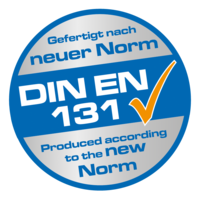
You will find this label directly on the product.
The standards do not address the handling of products according to old standard versions. However, for commercial users in Europe, the respective operating regulations apply. These regulations regulate the “minimum requirements for safety and health in the workplace when provided by the employer and use of work equipment by workers at their place of work", which is recorded in the German Industrial Safety Regulations (BetrSichV). An important component of these regulations is the obligation that work equipment must be kept up to date with the state of the art and a risk assessment must be conducted and regular inspections of the work equipment must be carried out.
Regardless of the regular ladder tests, we advise companies to carry out safety tests and risk assessments for their access systems in their inventory.
A good guide for a risk assessment is described in “Technical Rule for Industrial Safety (TRBS) 2121, part 2”. Only the operator can assess and decide whether a ladder can be used and this assessment must be documented.
According to section 4 of the German Occupational Safety and Health Act, hazards must be eliminated or mitigated directly at the source and primarily by means of technical protective measures. Is this not sufficient, you must take additional organizational and personal measures in the following order (also referred to as “T‐O‐P principle”.
T = Technical solution, e.g. mounting of a cross rail.
O = Organisational solution, e.g. instructions to employees regarding increased hazards.
P = Personal solution, e.g. use of personal protective equipment.
First and foremost, the technical solution is preferred. Only if the technical solution is not feasible, the organisational or personal solution will be implemented.
These specifications do not change. Companies still have to conduct and document a ladder test according to the current schedule. As a rule, this test should be carried out at least once a year. In case of higher loads or frequent use, the intervals should be shorter. The ladders used shall comply with the latest state of the art access technology and therefore with the legal requirements. In addition, the ladders should not be in a damaged state.
Most of the affected KRAUSE ladders can be updated to the latest standard using appropriate retrofit kits. KRAUSE Werk GmbH & Co. KG offers a comprehensive portfolio for this purpose. A classification of the ladders into either “Domestic use” or “Professional use” can also be carried out retrospectively, as the entire KRAUSE program has been checked and certified on the basis of the new specifications. For more information, please visit our website which is dedicated to the change of the standard at https://www.krause‐systems.co.uk/standard-en-131.
Retailers are allowed to sell hinged multi-purpose ladders, which were produced according to the old standard and are now in stock, even after the revised standard DIN EN 131-4 comes into force. Since the change of the standard is due to a regular revision and not due to an increased danger for users, the legislator assumes that a product complying to the old standard is not automatically unsafe and may therefore be resold. From 1 January 2018, manufacturers will have to comply with the requirements of the new standard and from that date may only produce or supply multi-purpose hinged ladders which comply with the new standard.
KRAUSE ladders meet the requirements of the legislation and all ladders comply with the class “Professional use”. Access technology from KRAUSE will be even more robust and long-lasting than ever before due to the new standard and the associated testing regime. In this way, accidents can be avoided and lost work can be reduced.
Due to the KRAUSE development of the Trigon Stabiliser, all STABILO and MONTO ladders continue to be used in full functionality. There is no requirement to remove separately usable ladder parts. The ergonomic aspect is a major factor, in particular with 3‐part-ladders, as the inner ladder can be removed and the transported weight can be reduced massively.
The changes to part 2 of standard EN 131 came into force on 1 January 2018 as well. The changes address mainly issues such as the durability tests and a new strength test. These tests classify both rung ladders and step ladders in two ladder classes ‐ ladders for “Professional use” and for “Domestic use”
- Professional Use: The “Professional use” category is for ladders that are designated for commercial and private use.
- Domestic use: The “Domestic use” category is for ladders that are designated for private use only.
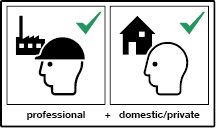
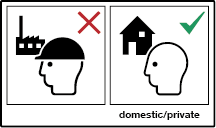
Strength Test:
The step/rung closest to the centre is loaded with a test load of F = 2,700 N (approx. 275 kg) for the class “Professional use”. The load is F = 2,250 N (approx. 229 kg) for the class “Domestic use”.
The test load is concentrated at a distance of 50 mm from the inside of the stile. The angle of inclination is 65° and thus very flat, so that the test load has its maximum effect.
When is the test passed?
The test is passed, if the ladder is undamaged and its function is maintained.
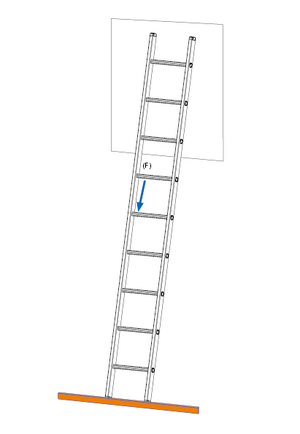 | 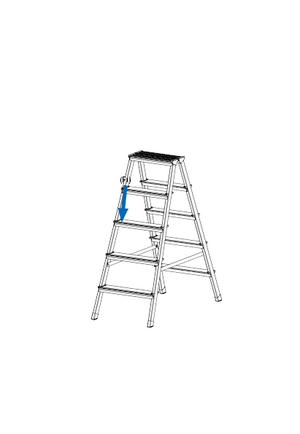 |
Torsion test of step ladders:
A ladder foot is fixed with a clamp. The platform or the upper step/rung of the ladder is loaded with F1 = 736 N (approx. 75 kg). Then, at a distance of 0.5 m from the centre axis, the ladder is pulled laterally with a load of F2 = 137 N (approx. 14 kg).
When is the test passed?
The test is passed, if the ladder foot has moved under load no more than 25 mm from its previous position.
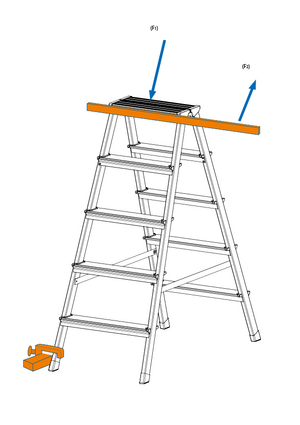
Torsion test of leaning ladders
In the first step, the ladders are preloaded with F1 = 491 N (approx. 50 kg) in the centre and the load is taken away after 30 seconds. This is the starting value.
A stile at its centre is loaded with F2 = 638 N (approx. 65 kg) and the deformation of both stiles is measured as compared to the starting value.
When is the test passed?
The test is passed, if the difference between the deformation of the two stiles is less than ≤ 0.07 (a) of the width of the ladders.
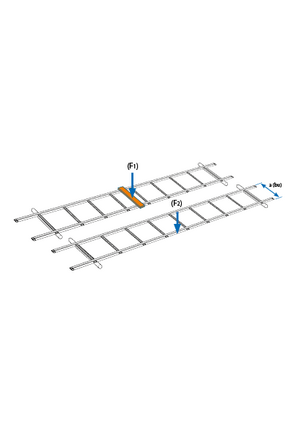
Durability test of standing ladders:
Under the right rear stile, a support of 20 mm height is positioned to simulate an uneven surface. This is followed by an alternating load at the top stand/top step (F1) and the step/rung in the centre of the ladder (F2) with 1,500 N (approx. 153 kg).
- For ladders of the class “Domestic use”, this is repeated for 10,000 cycles.
- For ladders of the class “Professional use”, this is repeated for 50,000 cycles.
When is the test passed?
The test is passed, if there is no damage to the supporting parts. This test serves as a preliminary test for the following test of the opening restraint device (not listed here as it is an unchanged test).
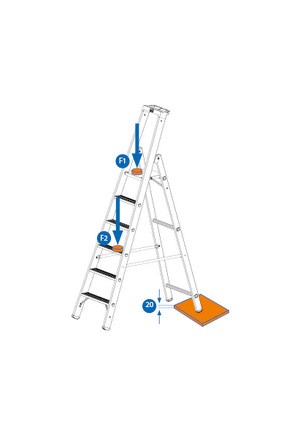
The third section of the standard DIN 131-3 stipulates the regulation governing the requirements for user information as well as the instructions for use and operation.
In conjunction with the entry into force of the standard, additional safety pictograms will be added to the labelling of the ladders. The pictograms attached are also dependent on the type of ladders (e.g. extending ladders, multi-purpose ladders, leaning ladders, etc.).
In addition to the new pictograms, user and operating instructions corresponding to the ladder type must also be supplied with the ladder. The user instructions shall be written in the official languages of the country where the ladder is placed on the market.

